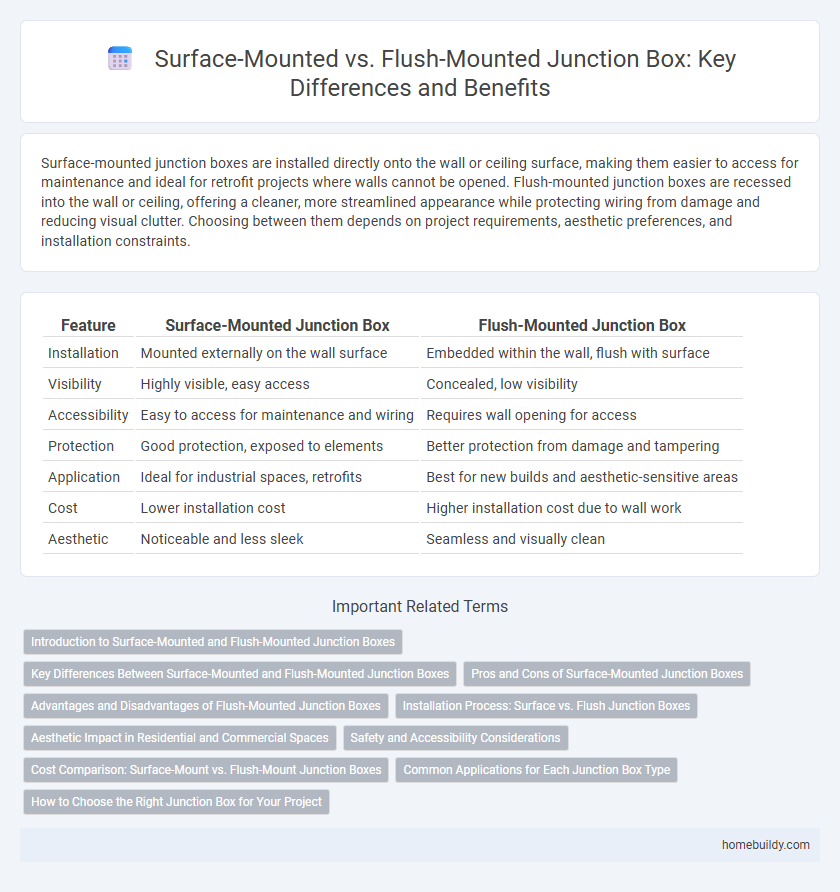Surface-mounted junction boxes are installed directly onto the wall or ceiling surface, making them easier to access for maintenance and ideal for retrofit projects where walls cannot be opened. Flush-mounted junction boxes are recessed into the wall or ceiling, offering a cleaner, more streamlined appearance while protecting wiring from damage and reducing visual clutter. Choosing between them depends on project requirements, aesthetic preferences, and installation constraints.
Table of Comparison
| Feature | Surface-Mounted Junction Box | Flush-Mounted Junction Box |
|---|---|---|
| Installation | Mounted externally on the wall surface | Embedded within the wall, flush with surface |
| Visibility | Highly visible, easy access | Concealed, low visibility |
| Accessibility | Easy to access for maintenance and wiring | Requires wall opening for access |
| Protection | Good protection, exposed to elements | Better protection from damage and tampering |
| Application | Ideal for industrial spaces, retrofits | Best for new builds and aesthetic-sensitive areas |
| Cost | Lower installation cost | Higher installation cost due to wall work |
| Aesthetic | Noticeable and less sleek | Seamless and visually clean |
Introduction to Surface-Mounted and Flush-Mounted Junction Boxes
Surface-mounted junction boxes are installed on the surface of walls or ceilings, allowing for easy access and simpler wiring modifications. Flush-mounted junction boxes are recessed into the wall or ceiling, creating a cleaner and more aesthetically pleasing appearance while concealing wiring connections. Both types serve to protect electrical connections, but their installation methods impact accessibility, maintenance, and visual integration within a building's design.
Key Differences Between Surface-Mounted and Flush-Mounted Junction Boxes
Surface-mounted junction boxes install directly onto walls or surfaces, offering easier access for wiring modifications and repairs, while flush-mounted junction boxes are embedded within walls for a cleaner, less obtrusive appearance. Surface-mounted options provide greater flexibility in placement and simpler installation, whereas flush-mounted boxes require precise wall cutting and concealment for aesthetic integration. Choosing between the two involves balancing factors like installation complexity, accessibility, and visual impact.
Pros and Cons of Surface-Mounted Junction Boxes
Surface-mounted junction boxes offer easy installation and accessibility, making maintenance and future wiring upgrades more convenient. Their external position protects internal wiring from wall damage but can be visually intrusive in aesthetic-sensitive environments. While they are cost-effective and suitable for retrofitting, surface-mounted boxes may be less secure against physical impacts compared to flush-mounted alternatives.
Advantages and Disadvantages of Flush-Mounted Junction Boxes
Flush-mounted junction boxes offer a sleek, unobtrusive appearance by being embedded within walls, enhancing aesthetic appeal in residential and commercial installations. Their design protects wiring from external damage and reduces fire hazards, yet installation complexity and higher labor costs are notable disadvantages compared to surface-mounted options. Limited accessibility for maintenance and repairs can also pose challenges, especially in older buildings without easy wall access.
Installation Process: Surface vs. Flush Junction Boxes
Surface-mounted junction boxes offer a straightforward installation process, as they are attached directly onto the wall or ceiling surface without requiring wall recessing, making them ideal for retrofitting and easy access to wiring. Flush-mounted junction boxes require cutting into the wall or ceiling to embed the box, ensuring a sleek, unobtrusive appearance but demanding more precise measurements and tools during installation. The choice between surface and flush mounting affects labor time, wall modification extent, and accessibility for future maintenance.
Aesthetic Impact in Residential and Commercial Spaces
Surface-mounted junction boxes offer easy installation but tend to be more visible, potentially disrupting the clean lines and modern aesthetic in both residential and commercial spaces. Flush-mounted junction boxes, recessed into walls, provide a sleek and seamless appearance that enhances design continuity and preserves interior decor integrity. Selecting a flush-mounted option is often preferred in high-end residential settings and professional commercial environments where aesthetic impact is a priority.
Safety and Accessibility Considerations
Surface-mounted junction boxes offer enhanced accessibility for inspections and repairs, reducing the risk of electrical hazards by allowing quick access without wall damage. Flush-mounted junction boxes are safer in environments where protrusions pose a physical risk, as they sit flush with the wall, minimizing accidental impacts. Choosing between surface and flush-mounted boxes depends on balancing ease of access for maintenance with safety requirements specific to the installation location.
Cost Comparison: Surface-Mount vs. Flush-Mount Junction Boxes
Surface-mounted junction boxes generally cost less due to simpler installation and minimal wall modifications, making them ideal for retrofit projects or exposed wiring. Flush-mounted junction boxes require more labor and materials for wall recessing, increasing overall expenses but offering a cleaner, low-profile finish preferred in new constructions and aesthetic-focused designs. Budget considerations often prioritize surface-mount options for cost efficiency, while flush-mount boxes justify higher costs through enhanced integration and visual appeal.
Common Applications for Each Junction Box Type
Surface-mounted junction boxes are commonly used in industrial environments, garages, and workshops where easy access to wiring for maintenance and modifications is essential. Flush-mounted junction boxes are typically installed in residential and commercial buildings, providing a clean, discreet appearance by embedding the box within walls or ceilings. Both types accommodate electrical connections but are selected based on accessibility needs and aesthetic preferences.
How to Choose the Right Junction Box for Your Project
Choosing the right junction box for your project depends on factors like installation environment, aesthetic preferences, and safety requirements. Surface-mounted junction boxes are ideal for retrofit projects or areas requiring easy access, offering straightforward installation on walls or ceilings without cutting into surfaces. Flush-mounted junction boxes suit new constructions or finished walls, providing a sleek appearance by embedding the box within the wall, which protects wiring and aligns with architectural design.
Surface-mounted junction box vs Flush-mounted junction box Infographic

 homebuildy.com
homebuildy.com